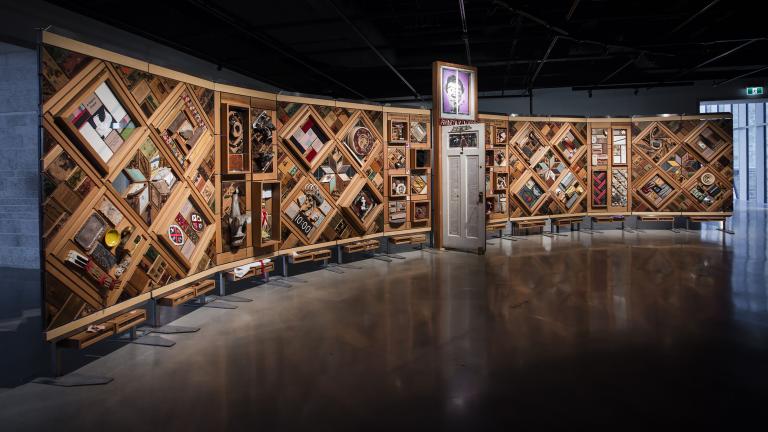This release is more than two years old
This release is more than two years old. For additional information, please contact Amanda Gaudes from our Media Relations team.
News release details
Indigenous concepts and Western legal principles have been united in a historically unique agreement signed by the Canadian Museum for Human Rights (CMHR) and artist Carey Newman today. The agreement covers the protection and use of The Witness Blanket, a powerful art installation made with over 800 items collected from the sites and survivors of Indian residential schools across Canada.
In an unprecedented move, written documents and an oral ceremony have been given equal weight in an agreement that vests legal rights with the artwork itself, as a living entity that honours the stories of the survivors.
“Rather than trying to decide our rights, we put the rights with the Blanket and the stories that were given to us by survivors,” said Newman (Ha‐Yalth‐Kin‐Geme), a First Nations artist and master carver from Vancouver Island. “We were not negotiating against each other but collaborating together in the best interest of the Blanket itself. We didn’t want to treat it like a transfer of property because I don’t feel ownership of the Blanket, I feel responsibility towards it and I wanted to make sure the Museum felt this too.”
Professor Rebecca Johnson, Associate Director of the Indigenous Law Research Unit at the University of Victoria, called the agreement “totally unique”.
“It has huge implications for me as a law professor because it models new and hopeful possibilities of seeing the law in its creative and expansive forms, not just as something that constrains and punishes,” she said. “It captures the heart of what’s possible when people work together to imagine new ways of drawing on law – both Indigenous and Canadian – to move us in a new direction.”
The Museum has taken the 12‐metre‐long, cedar‐framed artwork into its care and protection. Restoration work is needed after several years of travelling – which included an exhibition at the CMHR in 2015–16. A new travelling version has also been created, which will have its first showing at the Red Deer Museum + Art Gallery from May 4 to June 23.
CMHR President and CEO John Young said meaningful working relationships with Indigenous people create opportunities to learn, grow and share in new ways – which is also important to reconciliation. “Museums have sometimes assumed a unilateral authority to interpret Indigenous cultures and artifacts,” he said. “In collaborating with our Indigenous partners, we instead work to honour the perspectives, skills and experience they bring to the discussions.”
CMHR Head of Collections Heather Bidzinski researched positive examples from other cultural institutions but worked to create something entirely unique. “This agreement is based on understanding each others’ traditions in a mutually respectful way and recognizing that agreements are really about relationships – not about concepts of indemnity and ownership, which can be adversarial and confrontational,” she said.
A documentary film about the making of the Blanket will be shown to the public tonight at 7 p.m. at the Museum, followed by a conversation with Newman and film producer Cody Graham of Victoria‐based Media One. A free ticket is required. The film, Picking up the Pieces, screened last fall at the Vancouver International Film Festival.
Young said the Blanket is a work of national significance that provides a tangible framework for conversations about the genocide of Indigenous peoples in Canada. “Its stories, its objects and what they represent help us better understand this issue in terms of human realities and consequences instead of being just an abstract concept. As a national museum devoted to human rights education, we are committed to playing a meaningful role in sharing this truth as we work towards reconciliation.”
Newman is currently the Audain Professor of Contemporary Art Practice of the Pacific Northwest in the Department of Visual Arts at the University of Victoria, where The Witness Blanket was first publicly presented in 2014.
-30‐
This release is more than two years old
This release is more than two years old. For additional information, please contact Amanda Gaudes from our Media Relations team.
